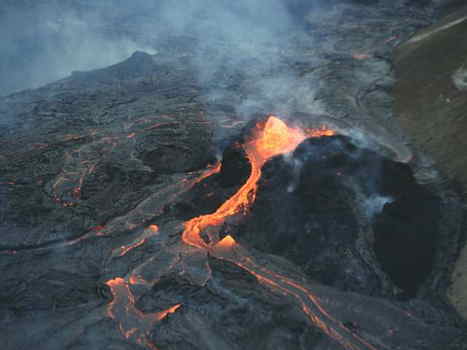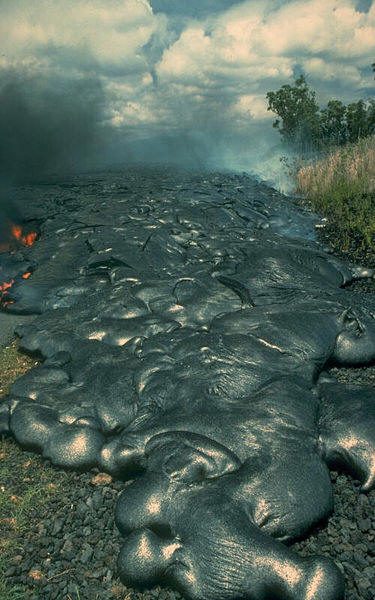 |
Volcano |

Meaning: a volcano is a hole in the Earth's crust through which gas, steam, molten rock and ash escape. Escaping ash and molten rock build up around the hole and over time can form into a mountain. Sometimes the gas, steam, molten rock and ash can be sent high up into the atmosphere as the result of a violent explosion. The area around the volcano can be completely destroyed. The volcano can also be destroyed in some instances.
Fast Facts:
-
the molten rock that comes from deep inside a volcano is called magma
-
when the magma is forced out of the volcano it is called lava
-
there are six volcano types, fissure, basic shield, dome, caldera, ash-cinder and composite
-
the name volcano comes from Vulcan, the Roman god of fire
-
Lava types are pillow, pahoehoe and aa
-
Ash, rocks and gas can move down the side of a volcano at speeds of 250km/h
-
Volcanologists study volcanoes
-
A thermocouple is used to measure the temperature in a volcano
-
Lightning can occur in a volcanic cloud due to the collision of particles of ash
-
Ash and particles can explode so high into the atmosphere that they are carried all around the world
-
Huge amounts of ash in the atmosphere can change the weather patterns
-
when the volcano erupted on Krakatua (1883) the explosion was heard 3,500km away and created a tsunami of more than 40m

Pahoehoe - Hawaiian
smooth lava.
Photographer: J.D. Griggs
| Types of volcanic eruptions: | |
| Vulcanian | a very violent eruption of thick lava and large lava bombs |
| Plinian | cinders, ash and gas erupt great distances into the atmosphere |
| Strombolian | gas, blocks, ash, cinders and small lava bombs erupt |
| Peleen | blocks of thick lava and a cloud of ash and gas erupt from the volcano |
| Hawaiian | runny lava erupt from the volcano |


Draw by
Luigi Chiesa

Drawing by
MesserWoland
1. Magma reservoir
2. Country rock
3. Conduit (pipe)
4. Base
5. Sill
6. Branch pipe
7. Layers of ash emitted by the volcano
8. Flank
9. Layers of lava emitted by the volcano
10. Throat
11. Parasitic cone
12. Lava flow
13. Vent
14. Crater
15. Ash cloud

Pyroclastic flows
descend the south-eastern flank of Mayon Volcano, Philippines.
Maximum height of the eruption column was 15 km above sea level, and
volcanic ash fell within about 50 km toward the west. There were no
casualties from the 1984 eruption because more than 73,000 people
evacuated the danger zones as recommended by scientists of the
Philippine Institute of Volcanology and Seismology.
Photograph by C.G. Newhall on September 23, 1984 (USGS)
Mount Mazama eruption timeline
